The AMD Radeon RX 480 Preview: Polaris Makes Its Mainstream Mark
by Ryan Smith on June 29, 2016 9:00 AM ESTPower, Temperature, & Noise
Given AMD’s focus on power efficiency with Polaris – not to mention the overall benefits of the move to 14nm FinFET – there is a lot of interest in just how the RX 480 stacks up when it comes to power, temperature, and noise. So without further ado…

When it comes to idle power consumption I'm posting the results I've measured as-is, but I want to note that I have low confidence in these results for the AMD cards. Ever since the GPU testbed was updated from Windows 8.1 to Windows 10, AMD cards have idled 3-5W higher than they used to under Windows 8.1. I believe that this is an AMD driver bug – NVIDIA’s cards clearly have no problem – possibly related to the GPU tested being an Ivy Bridge-E system. In this case I don’t believe RX 480’s idle power consumption is any higher than GTX 960’s, but for the moment the testbed is unable to prove it.
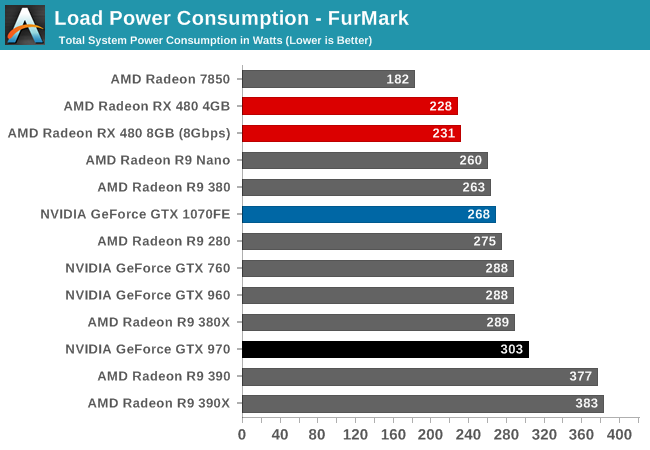
Traditionally we start with gaming load power before moving on to FurMark, but in this instance I want to flip that. As a power virus type workload, FurMark’s power requirements are greater than any game. But because it’s synthetic, it gives us a cleaner look at just GPU power consumption.
Among AMD’s cards, the RX 480 is second to only the Radeon HD 7850 in power consumption. Even then, as a GCN 1.0 card, the 7850 is one of the last AMD cards without fine-grained power states, so this isn’t a true apples-to-apples comparison. Instead a better point of reference is the GCN 1.2 based R9 Nano, which has a 175W TBP. Compared to the R9 Nano we find that the RX 480 draws about 30W less at the wall, which almost perfectly translates to the 25W difference in TBP. As a result we can see first-hand the progress AMD has made on containing power consumption with Polaris.
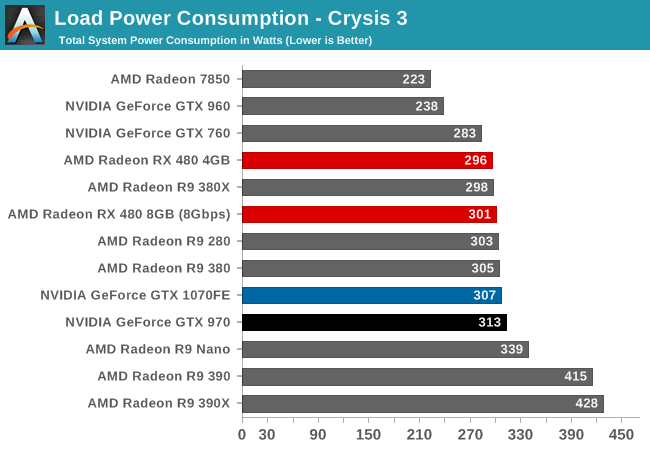
However things are a bit more mixed under Crysis 3. RX 480 is still near the top of our charts, and keeping in mind that higher performing cards draw more power on this test due to the additional CPU workload, the RX 480 compares very favorably to the rest of AMD’s lineup. System power consumption is very close to R9 280/380 for much improved performance, and against the performance-comparable R9 390, we’re looking at over 110W in savings. Hawaii was a solid chip from a performance standpoint, and Polaris 10 picks up where that left off by bringing down the power consumption to much lower levels.
The drawback for AMD here is that power consumption compared to NVIDIA still isn’t great. At the wall, RX 480 is only about 10W ahead of the performance-comparable GTX 970, a last-generation 28nm card. 1070FE further complicates matters, as its performance is well ahead of RX 480, and yet its power consumption at the wall is within several watts of AMD’s latest card. Given what we saw with FurMark I have little reason to believe that card-level power consumption is this close, but it looks like AMD is losing out elsewhere; possibly with driver-related CPU load.
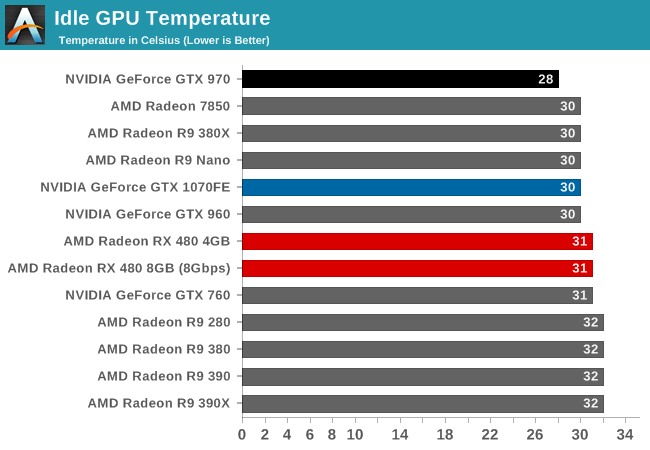
Moving on to idle GPU temperatures, there’s little to remark on. At 31C, the RX 480’s blower based design is consistent with the other cards in our lineup.
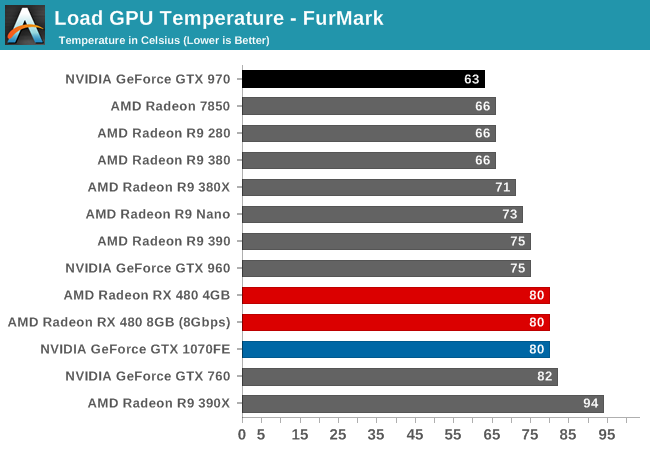
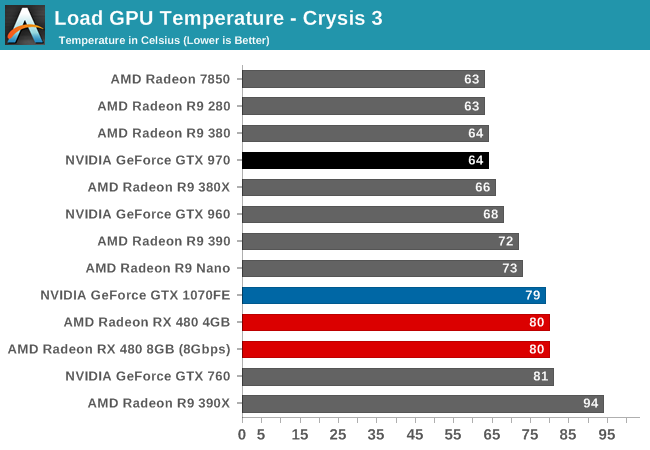
Meanwhile with load temperatures, we get to see the full impact of AMD’s new WattMan power management technology. The RX 480 has a temperature target of 80C, and it dutifully ramps up the fan to ensure it doesn’t exceed that temperature.

With idle noise levels RX 480 once again posts a good result. At 37.8dB, it’s in good company, only meaningfully trailing cards that idle silently due to their respective zero fan speed idle implementations.
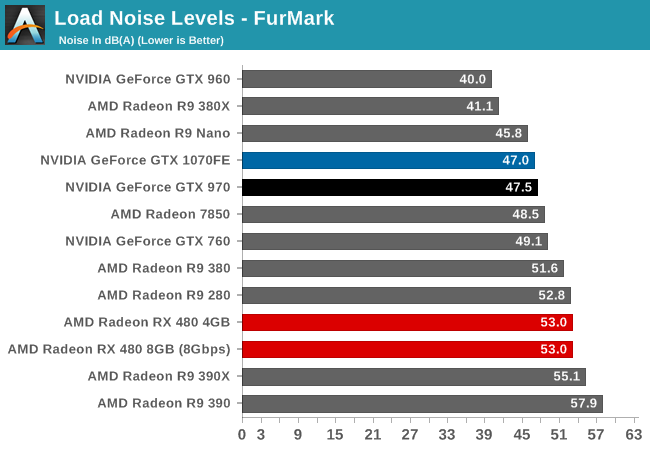
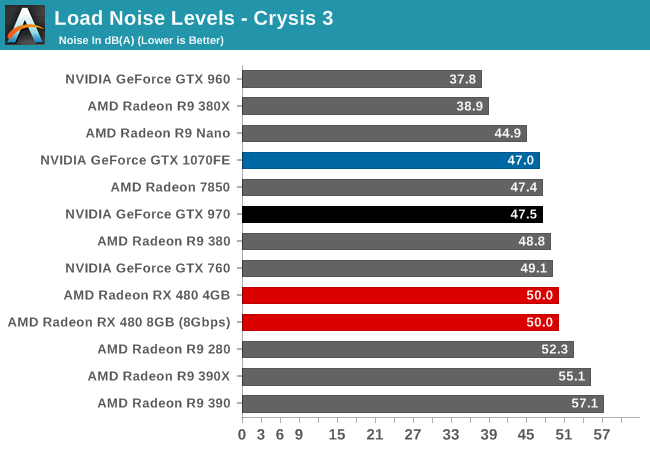
Finally, with load noise levels, RX 480 produces middling (but acceptable) results. Given that we have a mix of blowers and open air coolers here, the RX 480 performs similarly to other mainstream blower based cards. The $199 price tag means that AMD can’t implement any exotic cooling or noise reduction technologies, though strictly speaking it doesn’t need them.










449 Comments
View All Comments
catavalon21 - Wednesday, July 13, 2016 - link
The review HardOCP did on the 480 in CF mode against the 1080 and 1070 suggests YOUR statement missed the mark...if only I could type, or proofread, or something.AbbieHoffman - Wednesday, June 29, 2016 - link
Well! I was going to buy the RX 480 to replace my GTX 970, But it looks like there is no point! I really thought the 480X was going to perform better than the 980.Meteor2 - Thursday, June 30, 2016 - link
If you want to replace your 970 you're going to have buy a 1070.Laststop311 - Thursday, June 30, 2016 - link
Hopefully this brings price of 1070 down to 299.99 for the custom ones.vladx - Thursday, June 30, 2016 - link
Good luck with thatamitp05 - Thursday, June 30, 2016 - link
AMD need to push performance UP by 15% and power consumption DOWN 15%. To make this card truly tempting and to match the hype they created.But I'll still buy AMD. We need them :(
AMD: Please don't Hype Zen too much. It feels bad when expectation you created are not met.
AntDX316 - Thursday, June 30, 2016 - link
If you want to support AMD just get XB2 and PS5.D. Lister - Thursday, June 30, 2016 - link
Nah, last time my GPU died, I spent several months on a crappy IGPU. AMD, or ANY company for that matter, didn't come for my support. Then why should I support any of them?GPU2016follower - Thursday, June 30, 2016 - link
I don't even know why I come here maybe just by curiosity but I don't trust anandtech and their biased reviews always in favor of Nvidia cards. In the majority of other websites' reviwers just to name few: Techspot, Forbes, Polygon, arstechnica, PCgamer, ... the RX 480 easily dominates the GTX 970 in 95 % gaming benchmarks by an average from 5 and up to 10fps and the RX 480 manages in very few cases to trail the GTX 980 by only 2 or 3 fps below.I think I will wait for the custom versions to see if they can offer better performance, maybe we will see the Sapphire, ASUS, XFX RX 480 beefed with their more powerful OC versions to compete against the GTX 980.
AntDX316 - Thursday, June 30, 2016 - link
The microstutter is way higher than nvidias offerings..Unfortunately certain things aren't made common like adaptive vsync/gsync, micro stutter, frame draw response time. FPS is what most of the gamers look for and soley chase. I believe because they are too busy thinking about what they were taught before and/or too busy with whatever else they are doing in life other than keeping up-to-date of what does matter for the best gaming experience and why. It took a while for people to move away from the you can only see 24/30 fps and no more.